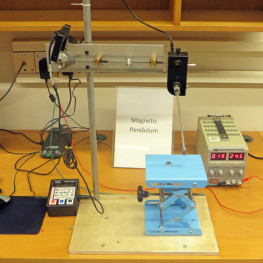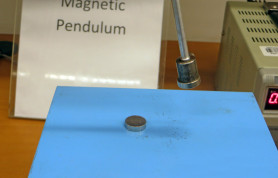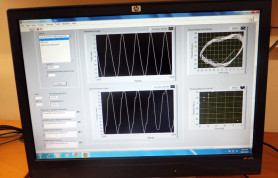| Student Manual |  Non-linearity is a profound concept in the study of physical systems. The characteristics of seemingly, very simple systems may turn out to be extremely intricate due to non-linearity. The study of chaos also begins with the study of such simple systems. The magnetic pendulum can be one such system. A pendulum is one of the simplest and diverse systems in terms of its mathematical basis and the range of fields of science that it can relate to. Without doubt, it is a gift of reflective simplicity for reductionist science. With slight modification, it can exhibit even exotically insightful phenomena, chaos being one of them. In this experiment, we will explore the notion of nonlinear and chaotic dynamics using a "magnetic pendulum". |
| Software Code | Download |
| Sample Results | Simulation of the magnetic pendulum showing affect of varying the distance between the magnet and the magnetic tipExperimental data showing affect of varying the distance between the magnet and the magnetic tip; as well as the initial conditionsHysteresis in the behavior of the magnetic pendulum |
| Experiment Code | 2.12 |
| Version | 22nd May 2015 |
Further Readings and References
- Applied Mathematics for Engineers and PhysicistsMcGraw-Hill Kogakusha Ltd, Loius A. Pipes, Lawrence R. Harvill, 598, (1970).
- Chasing Chaos with an RL-Diode Circuit, Junaid Alam, M. Sabieh Anwar, .
- Tools for detecting chaosEnstits Dergisi 9. Cilt, A. B. Ozer, E. Akin, SA Fen Bilimleri, 1, (2005).
- A unit of oscillations, determinism and chaos for introductory physics studentsAmerican Journal of Physics, Priscilla W. Laws, 72(4), (April, 2003).
- Nonlinear dynamics of a sinusoidally driven pendulum in a repulsive magnetic fieldAmerican Journal of Physics, A. Siahmakoun, V. A. French, J. Patterson, 65(5), (May, 1997).
- Experiments with a magnetically controlled pendulumEuropean Journal of Physics, Yaakov Kraftmakher, 28, 1007, (2007).
Pictorial Procedure



